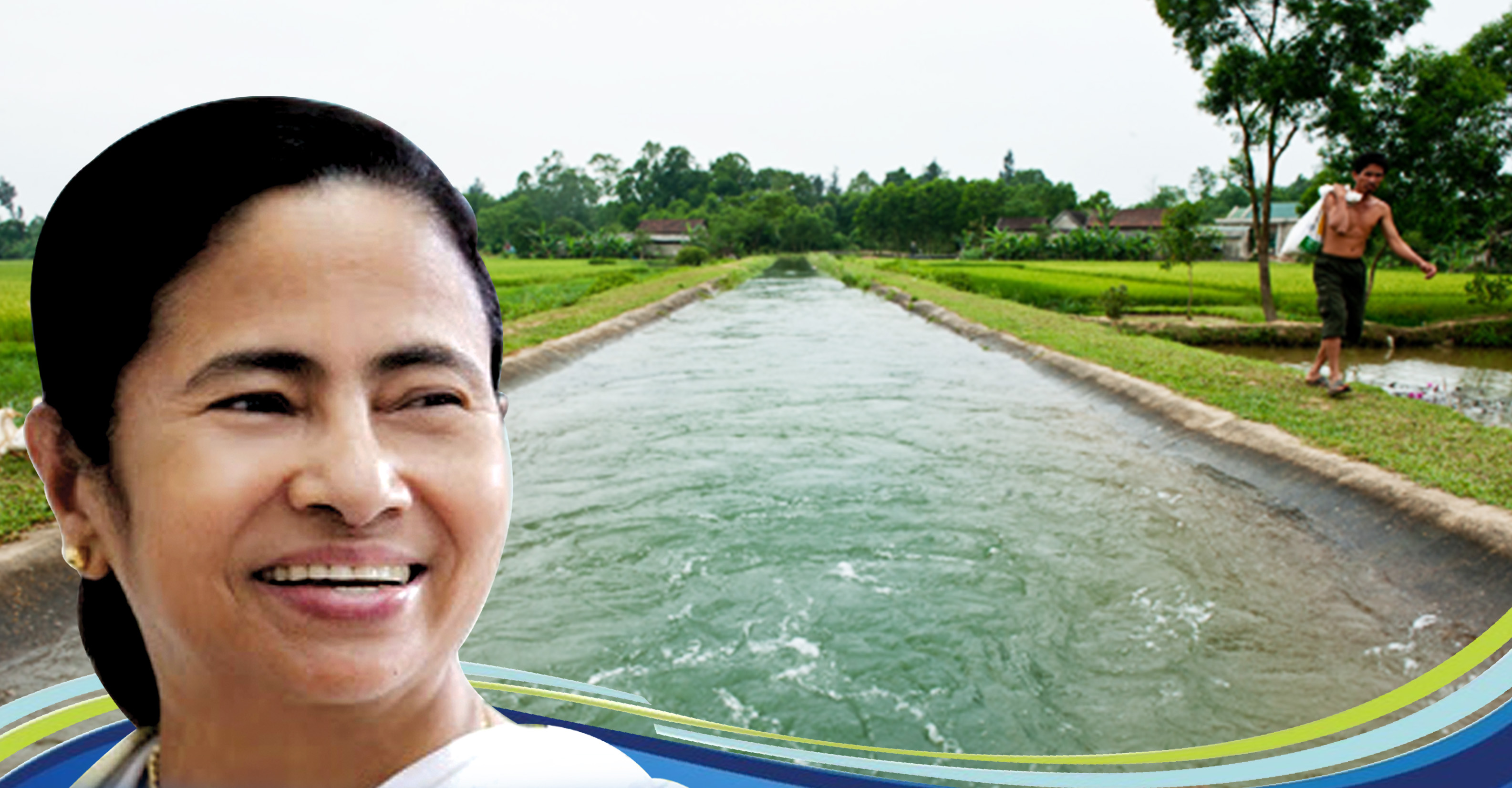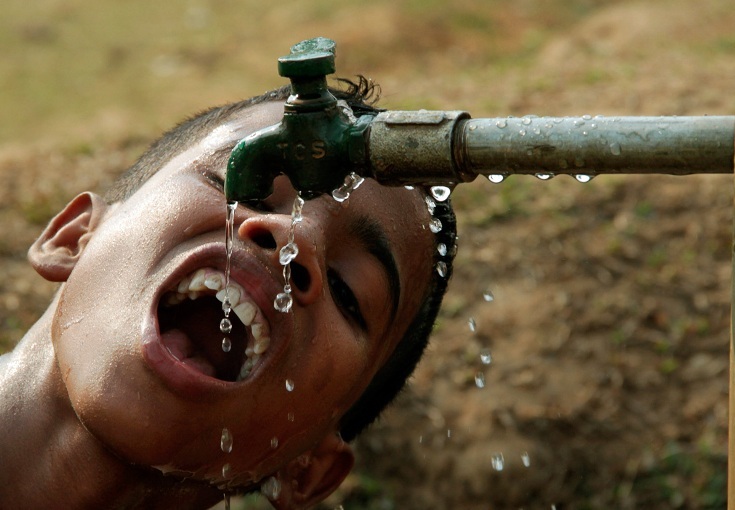The Bengal Government has taken numerous measures to make drinking water available in every part of the State. Efforts are continuously on towards achieving this. Piped Water Supply Schemes (PWSS) have been taken up across the State to make for healthy and happy lives.
The Public Health Engineering (PHE) Department Minister, in his departmental budget for financial year (FY) 2018-19, has outlined a number of measures to achieve self-sufficiency in generation, storage and distribution of drinking water.
District-wise special achievements during 2017-18
Bankura: A comprehensive water supply scheme covering a population of 30.15 lakh in 14 fluoride-affected blocks has almost been fully commissioned, at a cost of Rs 1,011.12 crore.
Purulia: PWSS covering a population of 15.3 lakh across nine blocks of the district at a cost of Rs 1,173.1 crore are being implemented, and will be commissioned by March 2019. The second phase of the project would cover the remaining 11 blocks, at a cost of Rs 4,289 crore.
South 24 Parganas: A surface water-based water supply scheme has been taken up for the 10 saline blocks of Kulpi, Diamond Harbour I and II, Falta, Joynagar II, Kultali, Magrahat I, Mandirbazar, and Mathurapur I and II, at an estimated cost of Rs 1,332.41 crore, covering a population of 32.87 lakh. Partial commissioning of the project will be done by April 2018.
North and South 24 Parganas: A surface water-based water supply scheme has been taken up, at an estimated cost of Rs 686.95 crore, for a population of 5.26 lakh, for the arsenic-affected areas of Haroa and Rajarhat blocks in North 24 Parganas district and Bhangar-II block in South 24 Parganas district.
Howrah: Bally-Jagachha Surface Water-Based Project Phase I has been taken up at an estimated cost of Rs 150.68 crore, covering six towns and a population of 2.86 lakh. Phase II of the project has been taken up at a cost of Rs 45.88 crore in Domjur block, covering a population of 98,782.
Purba Medinipur: Two surface water-based water supply schemes have been taken up for Panskura II block (at a cost of Rs 241.72 crore, based on the River Rupnarayan, to be commissioned in June 2018) and for the saline-affected areas of Nandakumar, Chandipur, Nandigram I and Nandigram II blocks at an estimated cost of Rs 811.38 crore, to benefit a population of 7.82 lakh.
Bankura: PWSS have been taken up for the blocks of Mejia, Gangajalghati, Indpur, Taldangra, Joypur, Kotulpur, Patrasayar and Sonamukhi as part of the Bankura District Phase II project, at an estimated cost of Rs 833.79 crore for a population of 11.03 lakh.
জনস্বাস্থ্য কারিগরি দপ্তরের জেলাভিত্তিক সাফল্য
মুখ্যমন্ত্রী মমতা বন্দোপাধ্যায়ের অনুপ্রেরণায় ২০১১ সাল থেকেই তৃণমূল কংগ্রেস পরিচালিত পশ্চিমবঙ্গ সরকার সবার জন্য জল সরবরাহে বদ্ধপরিকর।
পানীয় জল যাতে এই রাজ্যের সব জায়গায় সহজে পাওয়া সেজন্য রাজ্য সরকার প্রচুর প্রকল্প শুরু করেছে।
জনস্বাস্থ্য কারিগরি দপ্তরের মন্ত্রী শ্রী সুব্রত মুখোপাধ্যায় তার দপ্তরের ২০১৮-১৯ সালের বাজেটে পানীয় জল সংরক্ষণ এবং সঠিক ভাবে বন্টন করার জন্য নেওয়া বিভিন্ন পদক্ষেপের বিবরণ দিয়েছেন।
২০১৭-১৮ অর্থবর্ষে জেলাভিত্তিক সাফল্য
বাঁকুড়াঃ ১৪টি ফ্লোরাইড কবলিত ব্লকে ৩০.১৫ লক্ষ মানুষের জন্য একটি বিস্তারিত জল সরবরাহ প্রকল্প ইতিমধ্যেই চালু হয়েছে। এতে ব্যয় হয়েছে ১০১১.১২ কোটি টাকা।
পুরুলিয়াঃ এই জেলার নটি ব্লকে পাইপের মাধ্যমে পানীয় জল সরবরাহ প্রকল্প শুরু হয়েছে। এই প্রকল্পে উপকৃত মানুষের সংখ্যা ১৫.৩০ লক্ষ। এই প্রকল্পে ব্যয় হয়েছে ১১৭৩.১০ কোটি টাকা। এই প্রকল্পের মাধ্যমে আগামী ২০১৯ সালের মার্চ থেকে জল পাওয়া যাবে। দ্বিতীয় পর্যায়ে এই প্রকল্পে উপকৃত হবে ১১টি ব্লকের মানুষ, খরচ হবে ৪২৮৯ কোটি টাকা।
দক্ষিণ ২৪ পরগনাঃ কুলপি, ডায়মন্ড হারবার-I & II, ফলতা, জয়নগর-II, কুলতলি, মগরাহাট-I, মন্দিরবাজার, মথুরাপুর-I & II এর মত লবণাক্ত জলের ব্লকগুলিতে ভূপৃষ্ঠস্থ জলের সরবরাহ প্রকল্প ১৩৩২.৪১ কোটি টাকা ব্যয়ে গ্রহণ করা হয়েছে। উপকৃত হবেন ৩২.৮৭ লক্ষ মানুষ। এই প্রকল্প আংশিক ভাবে ২০১৮ সালের এপ্রিল মাসে শুরু হয়ে যাবে।
উত্তর ও দক্ষিণ ২৪ পরগনাঃ ভূপৃষ্ঠস্থ জল সরবরাহ প্রকল্প হাতে নেওয়া হয়েছে ৬৮৬.৯৫ কোটি টাকা ব্যয়ে। এতে আর্সেনিক কবলিত অঞ্চলের (যেমন উত্তর ২৪ পরগণার হাড়োয়া, রাজারহাট ব্লক এবং দক্ষিণ ২৪ পরগণার ভাঙড়-II ব্লক) ৫.২৬ লক্ষ মানুষ উপকৃত হবেন।
হাওড়াঃ বালি জগাছা ভূ-পৃষ্ঠস্থ জলপ্রকল্পের কাজ (ফেজ – ১) নেওয়া হয়েছে। এর জন্য বরাদ্দ করা হয়েছে ১৫০.৬৮ কোটি টাকা। এই প্রকল্প চালু হলে ৬ টি শহরের প্রায় ২.৮৬ লক্ষ মানুষ উপকৃত হবে। (ফেজ – ২) প্রকল্পের জন্য বরাদ্দ করা হয়েছে ৪৫.৮৮ কোটি টাকা। এর ফলে ডোমজুড় ব্লকের ৯৮,৭৮২ জন মানুষ উপকৃত হবেন।
পূর্ব মেদিনীপুরঃ এই জেলার জন্য ২টি ভূ-পৃষ্ঠস্থ জলপ্রকল্পের কাজ নেওয়া হয়েছে। এর মধ্যে একটি পাঁশকুড়া ২ ব্লকের জন্য, এতে বরাদ্দ অর্থের পরিমাণ ২৪১.৭২ কোটি টাকা। দ্বিতীয় প্রকল্পটি নেওয়া হয়েছে নন্দকুমার, চাঁদিপুর, নন্দীগ্রাম ব্লক-১ ও নন্দীগ্রাম ব্লক – এইসব নোনা জলের এলাকার জন্য। এর জন্য বরাদ্দ অর্থের পরিমাণ ৮১১.৩৮ কোটি টাকা এবং এর মাধ্যমে ৭.৮২ লক্ষ মানুষ উপকৃত হবে।
বাঁকুড়াঃ পাইপের মাধ্যমে জল সরবরাহ করার ১ টি প্রকল্প নেওয়া হয়েছে। বাঁকুড়া জেলার ফেজ ২ প্রজেক্টের আওতায় রয়েছে মেজিয়া, গঙ্গাজলঘাঁটি, ইন্দপুর, তালডাঙ্গা, জয়পুর, কোতোলপুর, পত্রসায়র ও সোনামুখী। এই প্রকল্পের জন্য ৮৩৩.৭৯ কোটি টাকা বরাদ্দ করা হয়েছে এবং ১১.০৩ লক্ষ মানুষ এর মাধ্যমে উপকৃত হবে।



